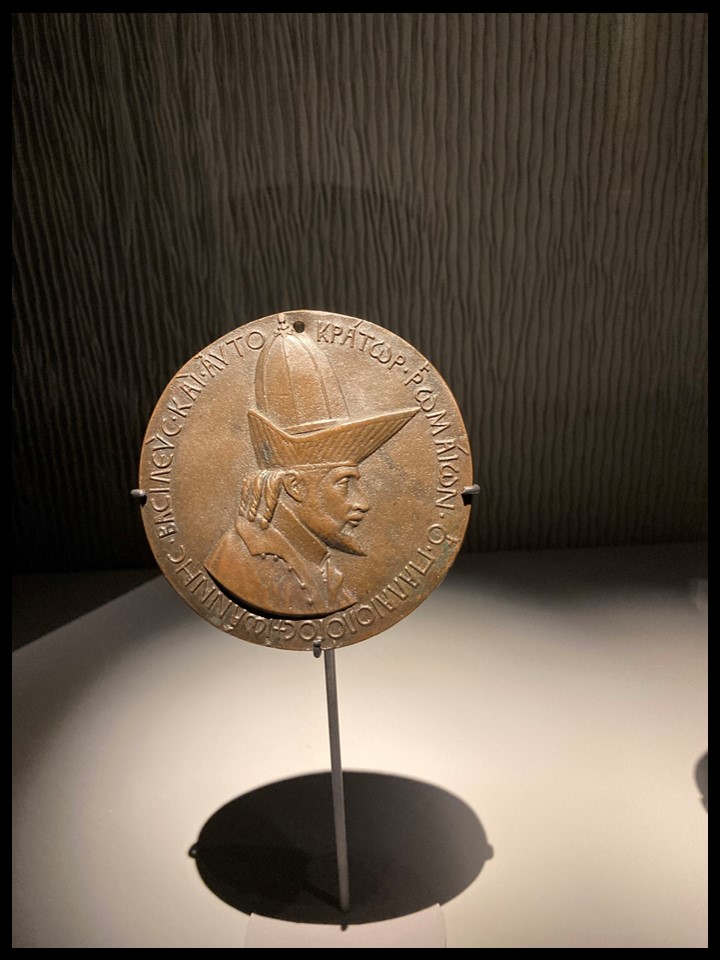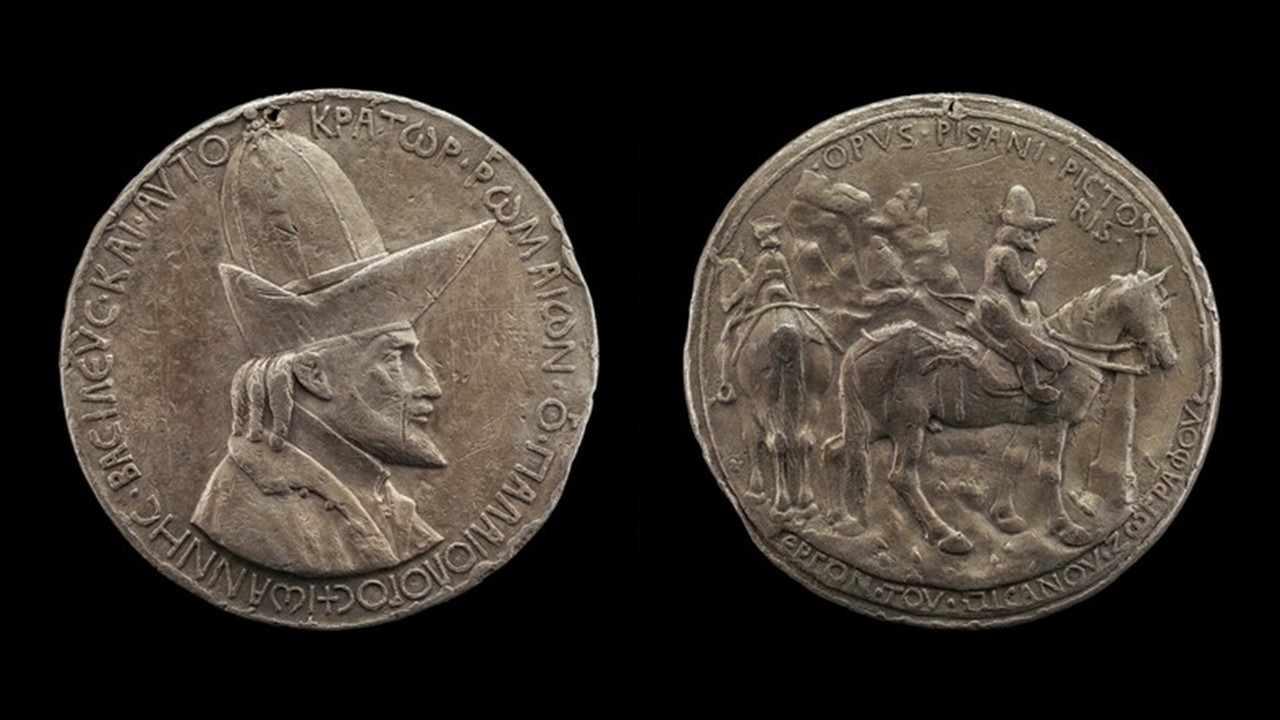
A page of Pisanello’s sketchbook in the Louvre Museum presents the mounted figure of the Byzantine Emperor Ioannis VIII Palaiologos and the short descriptive passage reads… The hat of the Emperor should be white on top and red underneath, the profile red all round. The doublet is green damask and the mantle on top crimson. A black beard on a pale face, hair and eyebrows alike. The eyes between grey and green, and the stooped shoulders of a small person. The boots of pale yellow leather; the sheath of the bow brown and grained, and also that of the quiver and of the scimitar. On the 5th of March, while in Paris, I visited the Hôtel de la Marine, and I came Face to Face with Emperor Ioannis VIII Palaiologos. Pisanello’s famous Medallion of the penultimate Byzantine Emperor was among the selected artifacts presented at the Exhibition Ca’ d’Oro, Masterpieces of the Renaissance in Venice (November 30, 2022 – May 7, 2023). I was touched… Some Preparatory Drawings for Pisanello’s Medallion of John VIII Palaeologus, by Michael Vickers, The Art Bulletin, Vol. 60, No. 3 (Sep. 1978), pp. 417-424 (8 pages) https://www.jstor.org/stable/3049816?read-now=1&seq=8#page_scan_tab_contents
Pisanello’s Medallion and two pages with preparatory drawings and comments, by Pisanello as well, one in the Louvre, the other in the Art Institute of Chicago, are vital in reconstructing the features and the physique of the Emperor. The Medallion I saw in Paris, like the rest of the exhibited artworks, loans from the Galleria Giorgio Franchetti at the Ca’ D’Oro, Venice, was an opportunity to read and refresh my knowledge of Ioannis VIII Palaionogos… his ‘works and days.’ https://www.thealthanicollection.com/hdlm/ca-doro-masterpieces-of-the-renaissance-in-venice
Ioannis VIII Palaiologos (or John VIII Palaiologos) was a Byzantine Emperor who ruled from 1425 to 1448. He was born on December 18, 1392, as the oldest son of Emperor Manuel II Palaiologos and Helena Dragaš. He was an intellectual, well-educated, and a patron of arts and learning. He was fluent in several languages, including Greek, Latin, and some Turkish. His reign was marked by a series of desperate attempts to save the Byzantine Empire from its rapid decline, particularly due to the increasing pressure from the Ottoman Empire.
In an effort to save his empire, he sought the aid of the West by advocating for a union of the Eastern Orthodox Church and the Roman Catholic Church. This led him to attend the Council of Ferrara/Florence (1438-1439), where he personally negotiated with Western leaders and agreed to a theological compromise that would allow for the churches to reunite. However, this decision was met with strong opposition from many within the Byzantine Empire, particularly the clergy and the people who saw the reunion as a betrayal of their Orthodox faith. Ultimately, the church union failed to secure the military and financial assistance Ioannis had hoped for, and the empire’s decline, continued, with a loss of territory and influence. Ioannis VIII Palaiologos died on October 31, 1448. Five years later, the Byzantine Empire ceased to exist. It was the 29th of May, 1453.
The Medallion of John VIII Palaiologos is a bronze portrait medal created by the renowned Italian artist Pisanello in 1438. This medallion, an outstanding example of Renaissance art, is considered one of the earliest examples of portrait medals in the history of art and stands as a testament to the diplomatic, cultural, and artistic exchanges that occurred during this tumultuous period in history. The medal is not only significant for its portrayal of the Byzantine Emperor but also for its role in the development of the art of medal-making in Europe.

Medal with John VIII Palaeologus (Ioánnis VIII), Emperor of Constantinople, 1438, National Gallery of Art, Washington, DC, USA
https://www.nga.gov/collection/artist-info.2228.html#works
Looking at Pisanello’s portrait of the Emperor, I wonder how John VIII Palaiologos felt during his trip to Italy. I am sure he hoped that by engaging in negotiations and pushing for the reunification of the Eastern Orthodox and Roman Catholic Churches, he could secure much-needed assistance from Western Europe. At the same time, he was also likely to have felt anxiety and pressure. The theological differences between the two churches were deeply rooted, and reaching a compromise would be a delicate and complex process. Furthermore, the Byzantine Emperor had to navigate diplomatic and protocol arrangements that were probably, at times, difficult and offensive, to put it politely.
Pisanello keeps his distance from the political intrigues and nuances. On the obverse side, the Emperor is depicted, in profile, dignified, imposing, and elegantly groomed. The artist displays individualized facial features, such as his well-groomed beard, high forehead, and strong nose. These details suggest an attempt to capture the likeness of the Emperor, rather than relying on stylized or idealized forms that were common in earlier periods. The clothing and adornments the Emperor wears, like his characteristic hat, reflect the luxurious aspects of Byzantine culture and provide a sense of authenticity to his portrayal. Around the perimeter of the obverse side, an inscription, in Greek, identifies the Emperor by name and title.
The reverse side of Pisanello’s Medallion, ‘signed’ by the artist in Latin and Greek, shows something entirely different. The Emperor, identified by his characteristic hat, is depicted astride his famous Eastern European horse, groomed for hunting. He is probably presented in the area of his residence, a convent outside Ferrara, where he indulged in his passion for the chase during the autumn of 1438. Was the Emperor depicted enjoying ‘personal time’ of relaxation, away from tension and stress? I wish he did…
For a PowerPoint inspired by Face to Face with Emperor Ioannis VIII Palaiologos, please… Check HERE!
For Face to Face with Emperor Ioannis VIII Palaiologos and Pisanello’s Medallion, please Check…
Some Prepatory Drawings for Pisanello’s Medallion of John VIII Palaeologus, by Michael Vickers, The Art Bulletin, Vol. 60, No. 3 (September 1978), pp. 417-424 (8 pages) https://www.jstor.org/stable/3049816?read-now=1&seq=8#page_scan_tab_contents
Some Notes on Pisanello and the Council of Florence, by James A. Fasanelli, Master Drawings, Vol. 3, No. 1 (Spring, 1965), pp. 36-47+84-93 (22 pages) https://www.jstor.org/stable/1552781?read-now=1&seq=10#page_scan_tab_contents
The Emperor John VIII Slept Here… by Kenneth M. Setton, Speculum, Vol. 33, No. 2 (April 1958), pp. 222-228 (8 pages) https://www.jstor.org/stable/2850780?read-now=1&seq=8#page_scan_tab_contents